Pangasinan salt farmers rise above unstable incomes, importation
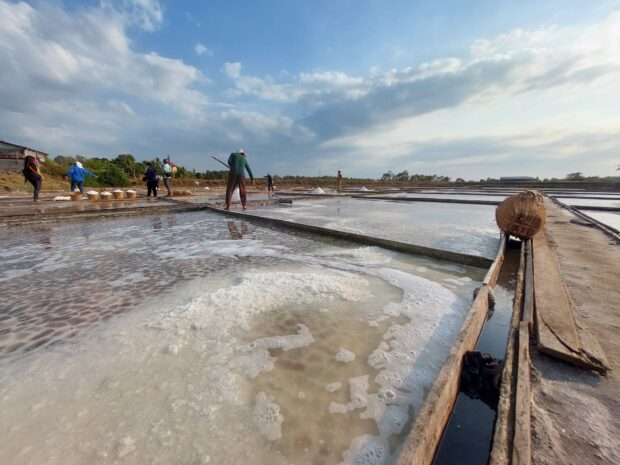
Salt farmers harvest the mineral in Dasol, Pangasinan on Thursday, March 9, 2023. INQUIRER.net/Jean Mangaluz
MANILA, Philippines — Amid the searing heat, salt farmers of Dasol town in Pangasinan province gather salt water and place them into rectangular basins. Then, they rake and collect the white crystalline mineral compound as it dries.
It was no easy work at all; often backbreaking. And the suffering of Dasol’s salt farmers is worsened by unstable income and the threat of importation since the Philippines – an archipelagic country – sources 93 percent of its salt from abroad.
READ: ‘Shameful’ for archipelagic PH to import salt, says Villanueva
On Thursday, the Department of Agriculture-Bureau of Fisheries and Aquatic Resources (DA-BFAR) and representatives from the offices of Senators Nancy Binay and Cynthia Villar held a dialogue with the farmers.
This initiative is part of efforts to help senators craft laws to revive the Philippine salt industry.
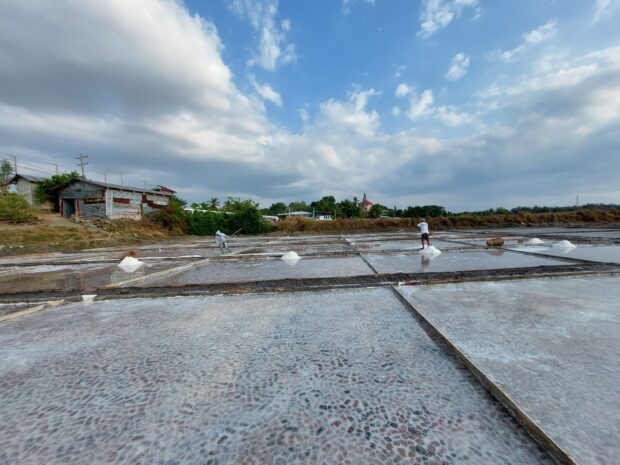
Salt farmers harvest the mineral in Dasol, Pangasinan, on Thursday, March 9, 2023. INQUIRER.net/Jean Mangaluz
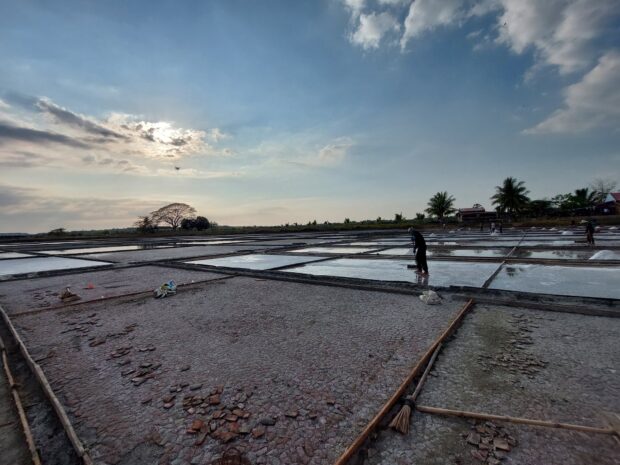
Salt farmers harvest the mineral in Dasol, Pangasinan on Thursday, March 9, 2023. INQUIRER.net/Jean Mangaluz
During the meeting, the farmers revealed that they only get one-third of the profits from the harvest because the remaining shares would go to landowners and other expenses such as production maintenance.
They also disclosed that since they are not considered employees but partners or helpers, they do not receive social security and health benefits.
The farmers explained that the profit for each harvest varies since the production volume depends on the number of times the sun provides enough sunshine to dry up the saltwater in the field. This means that cloudy skies and rain significantly challenge making salt.
It is likewise difficult to determine the actual average production and income because lots are owned by different people and cultivated by various farmers, they noted.
However, the farmers said they use the Filipino way of measuring yields called kaban which is roughly equal to 25 kilograms based on the standard metric system.
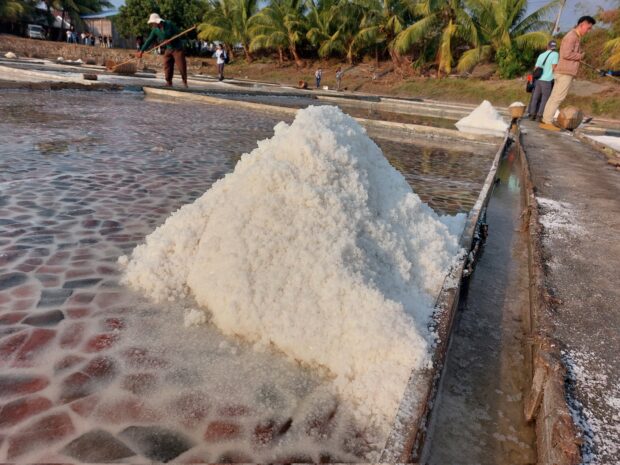
A mound of salt in one of the basins at a salt field in Dasol town in Pangasinan province, March 9, 2023. INQUIRER.net/Jean Mangaluz
According to them, they measure salt production through the number of salt beds they had prepared. For example, 25 salt beds can produce up to 35 kabans sold for P450 each. If all of it is sold, they get a net income of P393,750 divided into three – farmers, land owners, and production costs.
Thus, based on their computation, the one-third share of salt farmers from the income pie would amount to P131,250 for the six-month harvest season. And that is all – that’s why they consider the job an unstable source of income.
The farmers narrated that they start preparing the fields in November-December and that salt harvesting season runs from January to May – the only time they can make money from it since their work during the preparation period is unpaid.
So to generate additional income, salt farmers do different jobs during the off-season to feed their families and survive. For example, one salt farmer named Dante Baldorado would plant and sell crops.
“Magkano lang mapaparte mo dito (salt farming). Pagdating ng pag-ulan, wala rin, ubos din,” Baldorado said.
(You only earn a little from salt farming. When the rain comes, there’s nothing. It’s gone too.)
Noel Caberty, a salt farmer under the cooperative Producers of Quality Salt, said the government should give them more aid.
“Yung mga salt farmers po, wala po po talagang ayudang dumadating sa amin,” he said.
(The salt farmers, there is no help coming to us.)
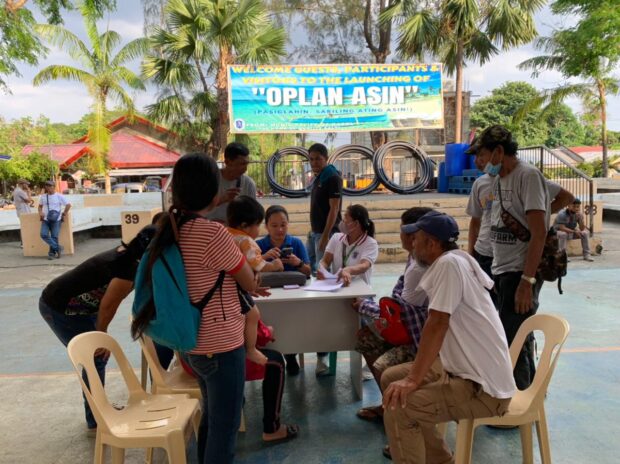
Officials from the Department of Agriculture-Bureau of Fisheries and Aquatic Resources, representatives from the offices of Senators Nancy Binay and Cynthia Villar, and local government leaders hold a dialogue with salt farmers in Dasol, Pangasinan on Thursday, March 9, 2023, in a bid to find a solution to their issues and revive the Philippine salt industry. INQUIRER.net/Jean Mangaluz
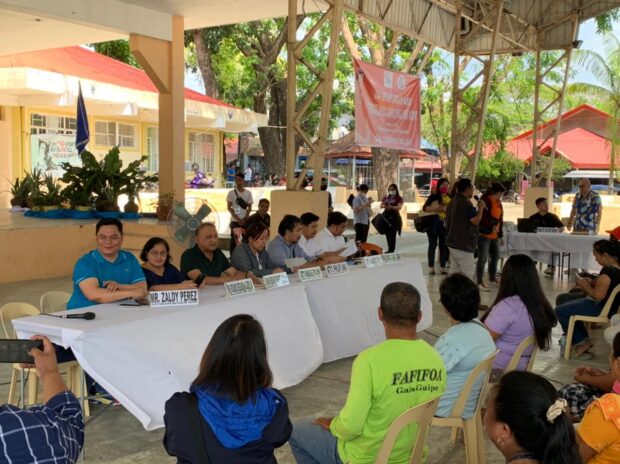
Officials from the Department of Agriculture-Bureau of Fisheries and Aquatic Resources, representatives from the offices of Senators Nancy Binay and Cynthia Villar, and local government leaders hold a dialogue with salt farmers in Dasol, Pangasinan on Thursday, March 9, 2023, in a bid to find a solution to their issues and revive the Philippine salt industry. INQUIRER.net/Jean Mangaluz
Form cooperatives
The DA-BFAR said aid is available for salt farmers but that they should organize into cooperatives so they may fully avail of the services and programs that the government has for them.
After the dialogue, the DA-BFAR set up a booth to help salt farmers register as cooperatives. The agency was also set to launch Oplan Asin on Friday, March 10, to assist the salt farmers in Dasol.
Oplan Asin aims to provide salt farmers with upgraded livelihood equipment to improve production and offer intervention and other aids, such as giving fishing boats to farmers so they can have other sources of income during salt production off-season.
The DA-BFAR also said that it intends to resolve the issue of the lack of data regarding salt production in Dasol through “profiling,” whose objective is to draw more comprehensive data on the Philippine salt industry.
READ: Salt industry revival plan to start with ‘profiling’ – DA
It noted, however, that profiling has been ongoing in Dasol and other salt-producing municipalities across the country, and the result of the undertaking would be by early 2024.
RELATED STORY
The problem of salt: Gateway for institutional and systemic reforms